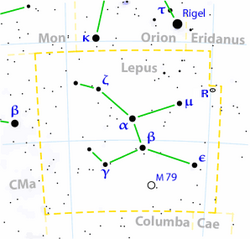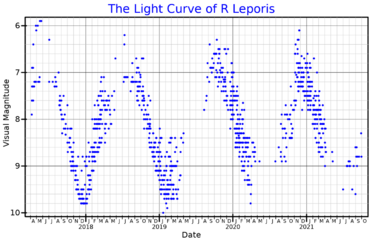Astronomy:R Leporis
| Observation data Equinox J2000.0]] (ICRS) | |
|---|---|
| Constellation | Lepus |
| Right ascension | 04h 59m 36.3487s[1] |
| Declination | −14° 48′ 22.518″[1] |
| Apparent magnitude (V) | 5.5 to 11.7[2] |
| Characteristics | |
| Spectral type | C7,6e(N6e)[2] |
| B−V color index | +5.74[3] |
| R−I color index | +1.47[3] |
| Variable type | Mira[2] |
| Astrometry | |
| Radial velocity (Rv) | 32.4 ± 2[1] km/s |
| Proper motion (μ) | RA: 7.51[1] mas/yr Dec.: −4.27[1] mas/yr |
| Parallax (π) | 2.42 ± 1.02[1] mas |
| Distance | 418[4] pc |
| Details | |
| Radius | 400 ± 90[5] R☉ |
| Luminosity | 5,149[4] L☉ |
| Temperature | 2,290[6] K |
| Other designations | |
| Database references | |
| SIMBAD | data |
R Leporis (R Lep), sometimes called Hind's Crimson Star,[7] is a well-known variable star in the constellation Lepus, near its border with Eridanus. It is designated "R" in the chart to the right.[1]
It is a carbon star which appears distinctly red. It is named after famous British astronomer J. R. Hind, who observed it in 1845. Its apparent magnitude varies from +5.5 to +11.7 with a period of 418–441 days; recent measurements give a period of 427.07 days. There may be a secondary period of 40 years.[3] R Leporis is too far from earth for its parallax to be measured effectively; Guandalini and Cristallo calculated the luminosity of Mira variables based on their periods. Using a period of 427.07 days, they calculated the bolometric luminosity to be 13,200 L☉.[8] It was estimated to around 1,350 light-years distant in a 2012 paper, shining with a luminosity approximately 6,689 times that of the Sun and has a surface temperature of 2,980 K.[9]
R Leporis has often been reported as an intense smoky red color, although this is not pronounced when the star is near its maximum brightness. It is reddest when it is dimmest, which occurs every 14.5 months. During these periods it is a candidate for the most-visible reddest star, but this claim is questionable. The red coloration may be caused by carbon in the star's outer atmosphere filtering out the blue part of its visible light spectrum. The star's discoverer, Hind, reported that it appeared "like a drop of blood on a black field."[7]
R Leporis as imaged by ALMA[10]
The light curve of R Leporis from AAVSO V band data[11]
References
- ↑ 1.0 1.1 1.2 1.3 1.4 1.5 1.6 1.7 V* R Lep -- Variable Star of Mira Cet type, database entry, SIMBAD. Accessed on line November 19, 2009.
- ↑ 2.0 2.1 2.2 R Lep, database entry, The combined table of GCVS Vols I-III and NL 67-78 with improved coordinates, General Catalogue of Variable Stars , Sternberg Astronomical Institute, Moscow, Russia. Accessed on line November 19, 2009.
- ↑ 3.0 3.1 3.2 HR 1607, database entry, The Bright Star Catalogue, 5th Revised Ed. (Preliminary Version), D. Hoffleit and W. H. Warren, Jr., CDS ID V/50. Accessed on line November 19, 2009.
- ↑ 4.0 4.1 McDonald, I.; De Beck, E.; Zijlstra, A. A.; Lagadec, E. (2018). "Pulsation-triggered dust production by asymptotic giant branch stars". Monthly Notices of the Royal Astronomical Society 481 (4): 4984. doi:10.1093/mnras/sty2607. Bibcode: 2018MNRAS.481.4984M.
- ↑ Hofmann, K.-H.; Eberhardt, M.; Driebe, T.; Schertl, D.; Scholz, M.; Schoeller, M.; Weigelt, G.; Wittkowski, M. et al. (2005). "Interferometric observations of the Mira star o Ceti with the VLTI/VINCI instrument in the near-infrared". Proceedings of the 13th Cambridge Workshop on Cool Stars 560: 651. Bibcode: 2005ESASP.560..651H.
- ↑ Lombaert, R.; Decin, L.; Royer, P.; De Koter, A.; Cox, N. L. J.; González-Alfonso, E.; Neufeld, D.; De Ridder, J. et al. (2016). "Constraints on the H2O formation mechanism in the wind of carbon-rich AGB stars". Astronomy & Astrophysics 588: A124. doi:10.1051/0004-6361/201527049. Bibcode: 2016A&A...588A.124L.
- ↑ 7.0 7.1 Richard Hinckley Allen (1899). Star-names and Their Meanings. New York: G.E. Stechert. p. 269. https://archive.org/details/bub_gb_5xQuAAAAIAAJ.
- ↑ Guandalini, R.; Cristallo, S. (2013). "Luminosities of carbon-rich asymptotic giant branch stars in the Milky Way". Astronomy & Astrophysics 555: 7. doi:10.1051/0004-6361/201321225. A120. Bibcode: 2013A&A...555A.120G.
- ↑ McDonald, I.; Zijlstra, A. A.; Boyer, M. L. (2012). "Fundamental Parameters and Infrared Excesses of Hipparcos Stars". Monthly Notices of the Royal Astronomical Society 427 (1): 343–57. doi:10.1111/j.1365-2966.2012.21873.x. Bibcode: 2012MNRAS.427..343M.
- ↑ "ALMA achieves its highest resolution observations" (in en). https://www.eso.org/public/announcements/ann23019/.
- ↑ "Download Data". AAVSO. https://www.aavso.org/data-download.
External links
- Best of the Advanced Observation Program: R Leporis
- USA Today.com - NightSky: The Hare and the Dove
- Smoky Mountain Astronomical Society - Hind's Crimson Star: R Leporis
- Geody Hinds Crimson Star
- Observations of R LEP from AAVSO
- Astronomy picture of the day
 |





